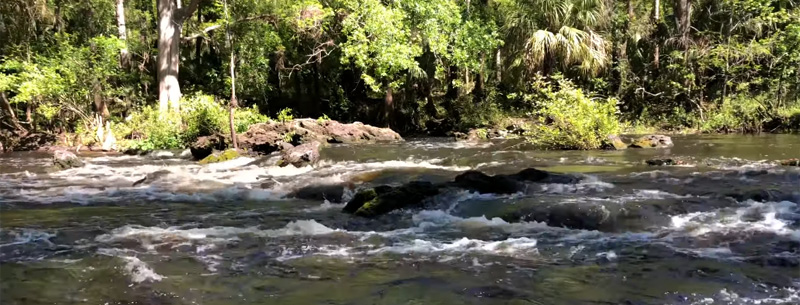Florida State Parks in the Tampa Bay Area
For a true appreciation of the beauty and diversity of the Sunshine State, nothing can equal a visit to one of Florida’s parks. Hiking through an oak hammock past trees that have stood before Columbus discovered the New World, you will feel you’ve traveled back in time. Watching a manatee cow and her baby from an underwater observatory, you will appreciate the simplicity and purity of nature. Florida parks are truly the Real Florida.
From swimming in a crystal clear spring to touring an antebellum mansion, Florida parks near Tampa offer something for everyone. Swimming, hiking, camping, fishing, canoeing, and picnicking are only some of the activities available to the park visitor. Each park showcases a unique and beautiful slice of Florida.
Caladesi Island State Park
Caladesi Island State Park – No. 1 Causeway Blvd., Dunedin, FL 34698; 727-469-5918
One of the few remaining undeveloped barrier islands in the state, most of coastal Florida used to resemble Caladesi Island. Pine and palm forests lead to rolling dunes covered with tenacious grasses and a long strip of white sandy beach. A relative newcomer to the Florida west coast, the island was created when a savage hurricane in 1921 separated it from what was then Hog Island. The origin of the island’s name is uncertain, though it has appeared on maps since the 1930s.
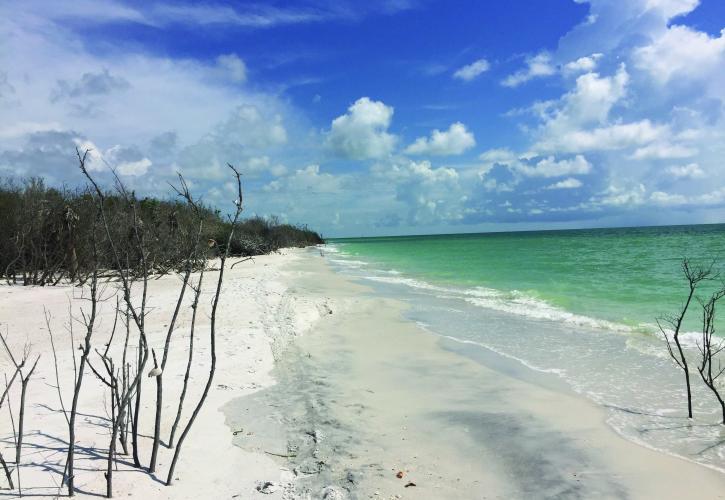
Accessible only by ferry from Clearwater and nearby Honeymoon Island State Park, a visit Caladesi Island makes a great day trip. You can fish, picnic, go boating or shelling, sunbathe on the beach, and wander at will through the pine and oak forests. A wide variety of birdlife calls the park home, and you’re likely to see an osprey soaring overhead. Picnic tables and concessions are located near the beach, and a 99-slip marina is available for those who bring their own boats. Overnight docking is permitted if you register with the park ranger.
Crystal River Archaeological State Park
Crystal River Archaeological State Park, 3400 N Museum Point, Crystal River, FL 34428
One of Florida’s most important pre-Columbian discoveries, the Crystal River State Archaeological Site consists of six ceremonial and burial mounds. These Indian mounds, some of the highest in Florida, mark the site of 1600 years of human habitation and as a memorial of a vanished civilization. The site has been excavated periodically since 1903, and a museum in the park details the excavations. The museum contains many artifacts, and an 8-minute video acquaints visitors with the site’s past. A small gift shop next to the visitor’s center sells various novelty and educational items.
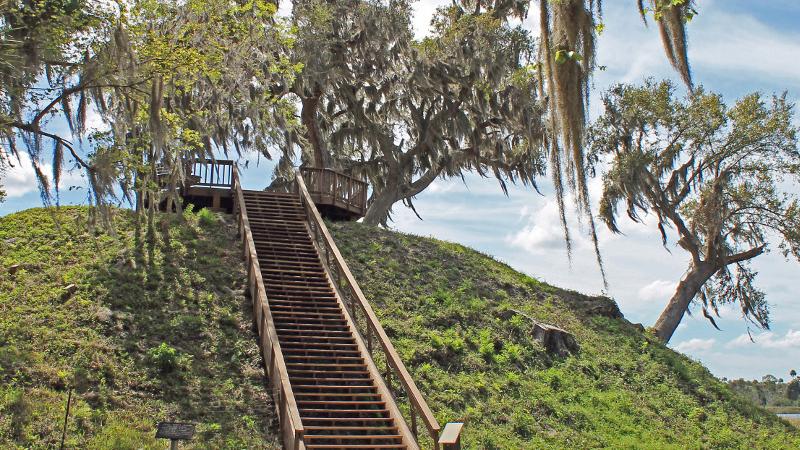
Interpretive trails lead visitors past the six mound sites, which include Temple, Burial, and Midden Area mounds. Two large limestone boulders seen along the trail may have served as ceremonial markers. The Temple mound also offers a beautiful view of the Crystal River from an observation deck built by the park service.
Fort De Soto Park
Fort De Soto Park, 3500 Pinellas Bayway S, St. Petersburg, FL 33715
A county park, Fort De Soto Park consists of a string of five small islands (keys) off the coast of St. Petersburg. The fort for which the park is named was built during the Spanish-American War in the late 1890s and is open to the public. The last brickwork fort built in the United States, the fort never saw action and was turned over to the county for use as a park in the 1940s. The beaches in the park are enormous, and numerous visitors stroll and sun themselves along their expanse while feeling totally isolated. North Beach faces the Gulf of Mexico, and East Beach offers a stunning view of the St. Petersburg Skyway. Massive picnic shelters are located at both the North Beach and East Beach areas.
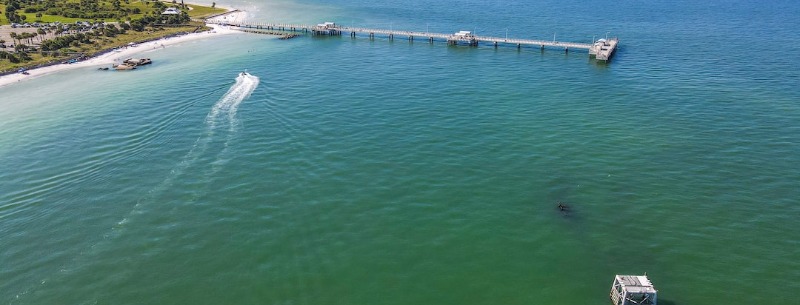
The campgrounds at Fort De Soto Park occupy all of St. Christopher Key. The campground offers 235 combination tent and RV sites, some of the bayside. The bayside campsites enjoy a picture-perfect setting of tall, tropical plants and shrubs, offering cooling shade and a perfectly framed window on the bay. The sites are strictly first-come, first-serve, with no advance reservations.
https://www.youtube.com/watch?v=IMEraJsbEjo
Gamble Plantation Historic Site
Gamble Plantation Historic Site, 3708 Northeast, US-301, Ellenton, FL 34222
Although people don’t usually think of Florida when envisioning the South before the War Between the States, many plantations were established and prospered there.
Most, however, we’re located in North Florida and the Panhandle. The sparsely settled peninsula created such difficulties with obtaining supplies and shipping products that few settlers were willing to take the risk. One man up to the challenge was Major Robert Gamble.
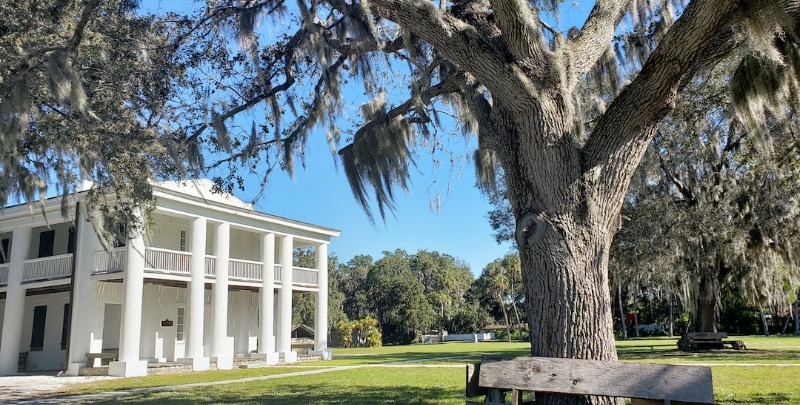
In 1844 Major Gamble, a veteran of the Second Seminole War decided to settle in the area of the Manatee River and establish a sugar plantation there. Leaving his brother’s successful plantation in Tallahassee, Gamble purchased 3,500 fertile acres northeast of what is now Bradenton. His plantation soon successfully produced sugar cane, molasses, citrus, grapes, and olives shipped to New Orleans. The mansion he built as his plantation home became the showplace of the area. Designed with hot Florida summers in mind, the Greek revival mansion’s red brick and tabby walls are nearly two feet thick. Strategically placed windows and a breezeway between wings let in cross breezes, and the home features upper and lower verandas that extend around three sides of the structure. Unable to sink wells due to the high amount of salt and sulfur in the groundwater, Gamble set up an elaborate water-catching system that still survives. The rain was collected from gutters and funneled to a building with a capacity of 40,000 gallons. Although Gamble had good years, bad years due to hurricanes and fires caused him to sell the estate in 1856.
During the Civil War, Union soldiers destroyed the sugar mill, perhaps for the scrap metal. As the Confederacy collapsed, Judah P. Benjamin, its Secretary of State, hid out at the mansion for three days during his attempt to avoid capture by soldiers. He later successfully fled to England and became a prominent barrister. Following the war, the mansion was sold to the Patten family. A second, smaller home was built on the property for Major Patten’s son, which is also open to tours. The Pattens fell on hard times, and a fertilizer company acquired the property for back taxes. The low point in the majestic home’s history was reached in 1920 when the company used the structure to store manure. The Daughters of the Confederacy saved the property in 1925 and restored the home to its former grandeur.
Today, visitors to Gamble Plantation State Historic Site can tour the beautiful mansion and grounds. The Patten House, an excellent example of a pioneer Florida farmhouse, is also open to the public. A visitor center features exhibits on Florida’s antebellum and pioneer periods, and a picnic area is located on the beautifully landscaped grounds.
Hillsborough State Park
Hillsborough State Park, 15402 US-301 N, Thonotosassa, FL 33592
A jewel in the State Park System, Hillsborough River State Park visitors are enthralled by this blackwater river flowing through a lush forest of pine and oaks. Its water is dark with tannin; the river offers great canoeing, for it is one of few rivers in the state with Class II rapids. A huge man-made, spring-fed swimming pool draws crowds of swimmers on hot summer days, and eight miles of hiking trails will delight the hiker and nature enthusiast.

One of the most popular activities in the park, canoeing the Hillsborough River offers everything from rapids to tranquil paddling through pristine natural surroundings. Canoe rentals are available in the park, however, rental canoes are not permitted on the rapids. If you wish to canoe this part of the river, rent a canoe from one of the vendors outside the park. The eight miles of hiking trails offer another great way to see this beautiful river, as several of the trails travel along its banks. The trails also wander through the hammocks of live oaks, sabal palms, and hickories that border the river. The trails are wide, however, the surface can be rough in areas due to erosion and exposed roots.
A visit to this park wouldn’t be complete without seeing Fort Foster, a recreated 1830’s fort located across the street from the park entrance. Volunteers clad in period dress re-enact the lives of the soldiers stationed at the fort, whose role was to protect a military road during the Indian wars. Call the park for information on tour availability and times.
Hillsborough River State Park features one of the best camping areas in the state. The campground is arranged in three loops to give a feeling of seclusion and offers 106 combination tents and RV sites, 84 with electricity. All of the sites have picnic tables, grills, and fire rings, and the campground has restrooms, a snack bar, laundry facilities, and hot showers conveniently located nearby. A big attraction in the summer months, the man-made spring-fed swimming pool offers a great way to cool off on a hot day.
Homosassa Springs Wildlife State Park
Homosassa Springs Wildlife State Park, 4150 S Suncoast Blvd, Homosassa, FL 34446
A showcase for Florida wildlife, Homosassa Springs State Wildlife Park enchants the visitor with its native animals and beautiful scenery. Formerly a tourist attraction, the Florida State Park System was fortunate to acquire the park for use as a rehabilitation center for injured manatees and other native Florida animals. The beautiful natural spring creates a perfect setting both in terms of appeal to the visitor and excellent habitat for the manatee, and visitors will especially delight in the underwater observation deck.
The park’s biggest attraction, the manatee, is always on hand to delight the visitor. Rangers offer interesting programs several times daily featuring these gentle giants. Alligators are the stars in another of these programs, which includes their feeding time, and other offerings include information on native snakes, otters, and other wildlife. A unique underwater observatory offers one of the best ways to observe the manatee as well as the thousands of fish in the spring. An easily walked trail takes you past the park’s other inhabitants, which include deer, otter, cougar, bear, alligators, crocodiles, birds of prey, and a hippopotamus (leftover from the tourist attraction).
In addition to the animal attractions, Homosassa Springs State Wildlife Park features scenic boat tours on nearby Pepper Creek, as well as a snack bar and gift shop. If you want to pack your own lunch, several picnic areas in the park offer great scenery to go along with your meal.
Honeymoon Island State Park
Honeymoon Island State Park, 1 Causeway Blvd, Dunedin, FL 34698
Before the advent of modern civilization, Honeymoon Island was simply one of many unnamed barrier islands along Florida’s west coast. At various times inhabited by Tocobaga Indians, Spanish explorers, pirates, and fishermen, the island was initially shown on maps as Sand Island. By 1880, the island became known as Hog Island, which it remained until was promoted as a resort for honeymooners in the early 1940s.
Today visitors can enjoy the beautiful white sand beach stretching the entire length of the island, including the only “pet beach” in the state. Swimming, sunbathing, and shelling are popular activities, as well as fishing for snapper, whiting, snook, and redfish in the surf and adjacent bay. Picnic pavilions, bathhouses, and concession stands are located within the park, and hikers can enjoy a trail leading through one of the few remaining virgin slash pine stands in South Florida. In addition, the park boasts several trails leading to bird observation areas.
Lake Manatee State Park
Lake Manatee State Park, 20007 FL-64, Bradenton, FL 34212
Three miles of shoreline along long, narrow Lake Manatee and 550 acres surrounding the lake is contained within Lake Manatee State Park. The lake offers excellent fishing, with largemouth bass, speckled perch, and shell cracker abundant. A fishing dock and boat ramp provide access to the lake, which is also excellent for swimming. A 60-site campground with full facilities is located within walking distance from the swimming and fishing areas, with a bathhouse and shower facility nearby.
Typical of this area of Florida, the surrounding wilderness consists mainly of pine flatlands and hardwood hammocks. Visitors to the park may hike the fire trails into the natural area, or enjoy the picnic area under shade trees. A wide variety of wildlife call the park home, including endangered gopher tortoises.
Little Manatee State Park
Little Manatee State Park, 215 Lightfoot Rd, Wimauma, FL 33598
Flowing 40 miles before emptying into Tampa Bay, the Little Manatee River winds through five miles of Little Manatee River State Park on its journey to the sea. The river’s steep, sandy banks lead to pristine sand pine scrub and oak hammocks, which provide habitat for various wildlife. Fishing and canoeing are favorite activities along the river banks, and a picnic area is located along the river allowing visitors to enjoy the area’s scenic beauty.
In addition to the area along the river, the park offers over 2,433 acres of wilderness to be enjoyed in a variety of ways. A 34-site campground is located in a woodland setting with electric and water hook-ups. Several miles of trails are open for horseback riding, with a limited number of primitive campsites available to equestrians along the trail system. Riders must furnish their own horses with proof of a recent negative Coggins test. A 6-1/2 mile hiking trail meanders through diverse habitats, providing access to primitive tent camping areas. Camping in these areas is by reservation only.
Rainbow Springs State Park
Rainbow Springs State Park, 19158 SW 81st Pl Rd, Dunnellon, FL 34432
Florida’s third-largest spring, Rainbow Springs pump 600 million gallons of water daily and serves as the headwater to the pristine Rainbow River. Operated for four decades as an attraction, the State Park Service acquired the property in 1990 and is slowly being allowed to revert to its natural state. Beautiful floral gardens surround the spring, and the area is immensely popular in the spring when the azaleas are in bloom. The state also acquired Rainbow Springs State Campground, located nearby, which was formerly privately owned. From the campground, you can tube or canoe the crystalline waters of Rainbow River or fish for largemouth bass and other freshwater species.
Especially popular in the warmer months, the cool clear waters of the springs attract swimmers of all ages. A picnic area is located in an area overlooking the mainspring and swimming area, with grills, tables, and covered pavilions available. A nature trail provides a leisurely 20-minute walk past two waterfalls and the azalea gardens and meanders along the Rainbow River.
Yulee Sugar Mill Ruins Historic State Park
Yulee Sugar Mill Ruins Historic State Park, Co Rd 490, Homosassa, FL 34448
A testament to the brave men and women who pioneered Florida in the days before air conditioning and modern medicine, Yulee Sugar Mill Ruins was the site of a 5,100-acre sugar plantation operated from 1849 to 1862. Operated by over 1,000 slaves, the mill was abandoned during the Civil War and the plantation house burned. The most imposing feature of the plantation, the sugar mill, was located near the Homosassa River.
Still standing today are the steam boiler, crushing machinery, and cooking kettles used to process the sugar cane, as well as the stonework chimney, well, and foundation. A pathway leads visitors around the ruins to interpretive signs that explain how the system worked. Across the street from the ruins, the park’s picnic area features tables, grills, and a pavilion.
